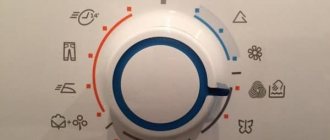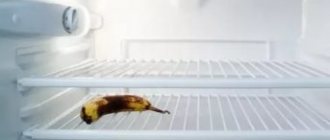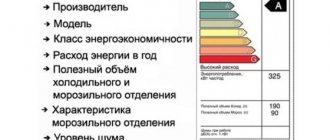Why do you need to wash
Food stored in the refrigerator can overflow and crumble, which contributes to the appearance of an unpleasant aroma in the refrigerator. The appearance of a layer of ice and frost on the walls of the unit, which forms as a result of warm air entering a closed space, can increase the load on the compressor. This will force kitchen appliances to consume more energy and exhaust their resources faster. These factors are the reason for regular defrosting.
Causes of Ice Formation
The ice layer is formed due to the evaporation of moisture and the penetration of warm air from outside. This also happens if you keep the door open for a long time.
IMPORTANT! If ice is not removed in a timely manner, the load on the compressor increases. As a result, it may fail.
The resulting layer makes it inconvenient to put in and take out food, increases energy consumption and reduces efficiency. The cause is damaged or worn rubber seals that refuse to fit correctly when the door is closed. When placing dishes and foods in the refrigerator whose temperature is higher than normal room temperature, this will also lead to the formation of ice.
Less common causes include:
- compressor overload;
- clogged capillary pipeline;
- faulty defrost sensor or cooling valve.
Do I need to defrost the refrigerator no frost
No frost is a modern refrigerator defrosting system. Frost does not form in such models. Thanks to the built-in fan, moisture is removed and deposited on a special evaporator. Single-chamber and double-chamber refrigerators are equipped with a no frost system. They are more economical, efficient and easy to maintain.
But even such devices also need to be defrosted. Little frost forms in them, but it still exists. After all, the door opens, warm air gets in, and some products evaporate moisture. In addition, the device must be washed periodically. It is recommended to carry out preventative manual defrosting annually.
How long
This largely depends on the thickness of the ice layer formed and the defrosting method. It must be borne in mind that it will take time for the subsequent restoration of work. It can take a whole day to remove a thick layer of ice. Only then will all surfaces be completely clear of plaque.
IMPORTANT! How long it takes to defrost the refrigerator is indicated in the attached instructions, which must be read carefully. If you follow all the recommendations and properly care for the refrigeration unit, it will last for a long time without breakdowns.
The principle of defrosting models of all brands without exception remains constant. The duration of the procedure may vary, depending on the defrosting system, as well as the frequency, which is influenced by the year of manufacture of the refrigerator.
Read simple tips on how to defrost a Stinol two-chamber refrigerator in this article.
How often should you defrost?
The frequency of defrosting the refrigerator is determined by the rate of ice freezing. It also depends on the model and the level of workload. It is recommended to free old refrigerators from ice every 1-2 months, modern ones - less often. But this procedure must be carried out annually, or better yet, once every six months.
Proper operation of refrigeration equipment extends its service life. To do this, you need to set the correct mode, monitor the placement of products, regularly defrost and wash. At the same time, it is important to take into account the nuances of the procedure in different models, to know how to quickly remove ice, how to turn it on correctly, what cleaning products to use for washing. Then the refrigerator will work without failures.
Life hacks to speed up the process
Sometimes it happens that you need to defrost the refrigerator much faster than planned according to the instructions.
In order to significantly speed up the process, you can use these proven life hacks:
- A piece of soft cloth must be moistened in hot water and wiped over the icy surface. As the material cools, it should be moistened again and again.
- Lay out a piece of clean cloth in several folds in the freezer. Fill a rubber heating pad with boiling water and place it on the material. Without closing the kitchen appliance door, wait for the water to cool completely.
- Place a wooden cutting board in the center of the freezer. Place a pan filled with hot water on it. The rising steam will melt the ice layer much faster. Do not use boiling water; it risks damaging the internal parts of the refrigerator.
Do you have a two-chamber refrigerator?
Not really
- Another effective way to speed up the process of melting frost inside the refrigerator is to spray the walls. Fill a spray bottle with warm water and start spraying the ice layer. Periodically collect the melted liquid with a cloth.
- For emergency defrosting, use special store-bought products. They contain components that accelerate the disappearance of ice from the walls and ceiling of the freezer. Such products not only help to quickly defrost the refrigerator, but also eliminate unpleasant odors, bacteria and mold. They are suitable for absolutely all models of kitchen appliances.
- Replace the fan heater with a hairdryer and get the same result. It’s just not safe to place it inside the camera, and holding it in your hands all the time is tiring. Also make sure that the flow of warm air does not blow over the seal.
- Use a vacuum cleaner to speed up the process. To do this, switch it to blowing, after changing the brush to a narrow nozzle. Direct the air flow alternately to different areas.
ADVICE! Open the refrigerator door and place a fan heater or heater opposite it. Do this so that melt water cannot reach them, and the air flow does not hit the rubber seal. This is one of the most effective ways to speed up defrosting.
Periodicity
The frequency of defrosting the refrigerator chamber is determined by the rate at which a layer of ice appears. The 7 mm thick “coat” must be immediately removed to ensure proper operation of kitchen appliances. It is also necessary to focus on the characteristics of a specific household appliance:
- Soviet models do not have a built-in auto-defrost system, so the defrosting procedure should be carried out quite often - no less than 2 times a month.
- A unit with a drip system, used in most modern models, develops ice on the rear wall during compressor operation. After turning it off, the melted frost flows in drops into a special container and evaporates from there. The disadvantage of this technology is that auto-defrosting only applies to the common chamber. And the freezer will have to be defrosted manually. The schedule and time of the procedure are usually set automatically and do not require user intervention.
- No Frost technology or dry freezing consists of a fan that distributes cold air. All condensed moisture evaporates directly in the cooling element. With such a system, the owner will not have to regularly defrost the unit, since No Frost applies to the entire refrigerator.
IMPORTANT! There are no devices that do not require defrosting at all. Even refrigerators with No Frost technology must be cleaned at least once a year.
The final stage of defrosting
After cleaning is complete, use a cloth or even a hair dryer to dry the walls of the device. This will help prevent unnecessary ice from forming again. Next, it is time to get your refrigerator running again.
Defrosting a refrigerator is an extremely important and useful procedure that greatly prolongs the life of the unit.
Insert the plug into the outlet and press the power button. The refrigerator takes time to “accelerate” to the desired temperature (about 30 minutes). After this, you can return the food to the freezer.
Thawed food should not be re-frozen, as this will significantly degrade its quality.
Step-by-step instruction
The main task when defrosting a refrigerator is to free the internal surfaces from frost while maintaining the freshness of food.
Manual defrosting can cause some difficulties, so it is better to use step-by-step instructions.
If you have a Liebherr refrigerator, we recommend reading detailed defrosting instructions here.
ADVICE! If the kitchen unit consists of two isolated chambers, then defrosting can be done alternately, transferring food from one compartment to another.
Turning off the device
First of all, you need to set the temperature regulator to zero and disconnect the kitchen appliances from the mains by removing the plug from the socket. This is done in order to eliminate the possibility of electric shock while cleaning the “insides” of the unit.
Product extraction
Next, remove food from the chambers and move it to storage so that it is exposed to warm air as little as possible. You can store them during defrosting in different ways:
- if it’s a cold season outside and you have a balcony, then it is recommended to move the food into a basin and take it out into the fresh air;
- purchase thick food foil or a thermal bag in advance and put food there;
- move the food from the refrigerator into a large pan and take it to the bath, placing it in cold water;
- If you live in a private sector, then while defrosting, containers with food can be taken to a cold cellar.
We recommend that you read other articles on our website: How to clean a coffee machine with citric acid - simple recipes
Removing shelves and drawers
After freeing the kitchen appliance from the food, proceed to remove all loose parts of the refrigerator. Carefully remove drawers, trays and shelves and wash them using liquid dish soap. Use only soft cloths or sponges.
Do not use solvents, bleaches, car cleaners, essential oils, or abrasive cleaners. They can damage the surface of the device or even cause a fire.
Flood protection
To avoid flooding the room with melt water, do not forget to check the patency of the built-in liquid drainage tube. It should come out from the back into a special tray. It is recommended to direct it into a basin or bucket. Don’t forget to empty the water from the special defrosting container as it accumulates. Place old towels or wrinkled newspapers near the back of the machine. Also place a thick cloth under the refrigerator to prevent water from damaging the flooring.
Selecting a method
Based on the built-in technology of the household appliance, choose the appropriate defrosting method. If the procedure is carried out at a normal, non-accelerated pace, then simply leave the door open and periodically check the condition of the chambers. On average, defrosting lasts from 2 hours to a day. It all depends on the thickness of the ice on the walls, the volume of the chambers and the air temperature in the room.
Removing ice
Never try to speed up cleaning your refrigerator by physically removing ice. Only natural melting or its artificial acceleration by adding a heat source or special chemicals. Any physical intervention can damage the internal coating of the unit, which will predictably lead to its damage. The maximum permissible action is to easily remove the layer, the removal of which can be determined visually. Take it with your palm and carefully separate it from the ceiling or wall of the chamber.
Read about how to clean the inside of the refrigerator after defrosting here.
Water purification
After the main flows of water have merged into a special receiver, excess liquid should be removed from the body. Dry rags or kitchen towels work great. Try to select absolutely all the water, because otherwise, when you turn on the device, they will become a place for new rapid formation of ice.
Drying and airing
To be more sure that not a drop of liquid will remain in the refrigerator, leave the doors open for another couple of hours. At the same time, create a draft in the kitchen. Let the insides of the unit be additionally blown with air currents. This will eliminate the possibility of rapid condensation after turning on the refrigerator and will completely remove any remaining unpleasant odors.
Leak test
While the last drops of moisture are drying, it is recommended to carry out additional diagnostics of the parts of the kitchen appliance. Carefully inspect the rubber seals on the chamber doors. If dry areas are found, they should be immediately treated with silicone grease. If it is not available, regular sunflower oil will do, but it must be refined. If you find cracks and other damage, then you should think about completely replacing the gasket. After all, it is she who is responsible for the tightness of the refrigerator, keeping warm air from getting inside.
Connecting the device
After completing all these manipulations, you can turn on the equipment to the power supply. Just don’t rush to put shelves, drawers and food items back in their original places. First, give the device time to reach the required temperature. This usually takes up to half an hour. This will help extend the life of your assistant and prevent the rapid development of new ice build-up.
In this article you can find detailed instructions on how to turn on the refrigerator after defrosting.
Useful tips
In order to remove stains and unpleasant odors from the kitchen unit, prepare a soda solution in advance, which is recommended to rinse the inside of the refrigerator after the ice has disappeared. Its components are simple:
- 1 tbsp. l. soda;
- 1 liter of warm water.
Wash the walls of the chamber with the resulting solution using a soft cloth. Microfiber works great.
If, while unloading the refrigerator, you suddenly find food or kitchen utensils frozen to the inner shell of the refrigerator, do not try to tear them out of the ice. Let this object separate from the wall on its own during the defrosting process. Otherwise, you will face expensive equipment repairs.
In this article you will read about how to defrost the Biryusa refrigerator with your own hands.
IMPORTANT! Use accelerated defrosting methods as little as possible . Despite all the apparent safety of the chemicals used in this situation, such a procedure reduces the service life of the refrigerator by 25%.
It is better to defrost in the cold season. In summer, under no circumstances should the refrigerator be left for a long time without power, otherwise high air temperatures will prevent the device from restarting correctly. During startup, it will take a very long time to reach the required temperature, which will negatively affect its service life.
Under no circumstances use folk advice regarding defrosting, especially if it contradicts common sense. It is prohibited to treat the inside of the refrigerator with salt and vinegar to speed up the procedure. These products may damage the plastic sheathing.
What not to do when defrosting
Sometimes, after defrosting, the refrigerator begins to malfunction, cools worse, or frost forms faster than before. Common mistakes can lead to such problems. What not to do when defrosting the refrigerator:
- chip off the ice with a knife or scrape it with sharp objects or hard brushes;
- peel off the ice crust using force;
- heat rubber seals;
- turn on the refrigerator after defrosting without drying it.
Important!
You can turn on the refrigerator after defrosting only after drying all the moisture!
It is also often not recommended to carry out this procedure on hot days. It is believed that at elevated air temperatures when turned on, the compressor may overheat, cooling the heated walls. You can avoid this by turning it on at night when it is cooler.
Do not scrape ice with sharp objects











